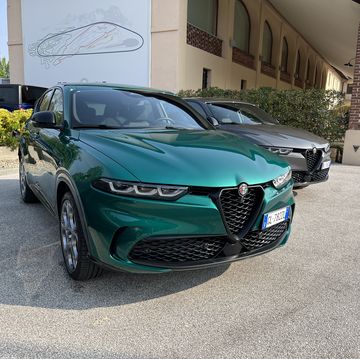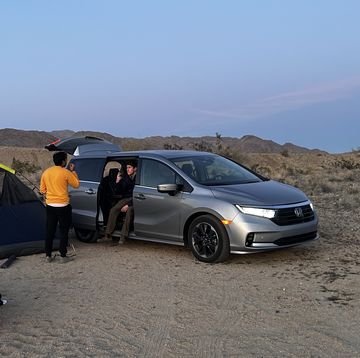When it comes to electric cars, two motors are better than one. Usually. Well, mostly.
Volvo is updating its C40 Recharge and XC40 Recharge smallish SUVish electric things for 2024 with new drivetrains. Both all- and two-wheel-drive models get a new Volvo-designed electric motor that powers the rear wheels. The all-wheel-drive model gets a second electric motor (a different one not designed by Volvo) that turns the front wheels. Both drivetrain variations were on hand at a press event in Volvo’s hometown of Gothenburg, Sweden. The pre-production, euro-spec C40 coupe-like machine had the single motor and the squarer-cut XC40 the dual setup.
This also marks the return of rear-wheel drive to the Volvo line up for the first time since them rectilinear 900-series (later rebranded as the S90 sedan and V90 wagon) left production during 1998. Based upon observations while driving around Gothenburg, many of those ancient 900s are now running around Sweden driven by feral teenagers who have cut their springs down so far that they launch skyward like Stomp Rockets going over speed bumps.
The new Volvo electric motor is compact and pairs with a planetary gearset that acts as the differential. The all-wheel-drive version uses slightly higher voltage to spin at slightly higher speeds than the rear-drive version. So, the rear-driver’s motor is rated at 248 hp while the all-wheel driver’s rear motor goes at 255 hp. Plus, of course, the all-wheeler also gets a second asynchronous electric motor up front that contributes 147 hp to the party. That’s a total pony count of 402. Yeah, the all-wheel-drive versions are quicker.
With even the start button banished, once XC40 Recharge senses that the key is aboard, it’s a matter of simply putting the selector in drive and then heading out onto the road.
The XC40 Recharge had all-wheel drive aboard and Volvo claims a 0-60 clocking of about 4.7 seconds. It feels even quicker thanks to the instant delivery of torque. The driving character can be personalized through a menu on the large center screen. Leaving the system in “one-pedal” operation and with the steering effort set on firm, it’s not a particularly rewarding car to pilot. The regenerative braking is too aggressive and the steering is unpleasantly heavy. Turning off one-pedal results in a much more natural feeling driving experience and turning off the firm steering feel takes stress off the driver’s biceps. The all-wheel-drive version feels best when it’s running on its most basic settings.
Meanwhile, the two-wheel-drive C40 Recharge feels like a slug compared to its more muscular brother. No shock there. What is surprising is how much better the steering is when the front wheels aren’t tasked with delivering any power. The initial turn-in entering corners is more immediate. There’s more feedback through the steering wheel, and with the firm setting turned down, it takes less arm strength to turn the steering wheel. Still, it’s not so much better than the AWD that it would be a good trade-off for the thrust that comes with two motors. That sudden whoosh that comes with the dual motors is intoxicating.
In light of that, here comes the twin subjects of range and charging. New battery packs cram more zappage into each of the Rechargers. The 79 kilowatt-hour pack has the rear-drive C40 carrying an EPA-rated 297-mile range, a hair better than the rear-drive XC40 going out 294 miles. And that comes with ability to ripen the battery charge from 10- to 80-percent in a claimed 28 minutes using a DC fast charger.
The AWD models use a 75 kilowatt-hour pack that rates out at 254 miles in the XC40 Recharge and 257 in the C40 Recharge. That’s up 31 miles from the 2023 models.
On this short driving exposure to the new vehicles, there was no chance to drain the batteries completely or test the charging time. Those opportunities will come with longer drives back in America. That in mind, the battery usage as reported by each vehicle’s on-board computer was in line with those expectations.
What Volvo has going for it right now is good styling, excellent on-board tech toys, and some of the best seating in the business. The interior of the driven C40 was too monochromatically black, but the wool textile upholstery breathes well, is soft to the touch, and plain looks great. Volvo is retreating from using leather in its interiors and that’s OK. Even ravenous carnivores will appreciate this vegan upholstery. And that material covers near-perfectly shaped seats: firm, but well-shaped and affirmatively supportive (particularly the thighs and torso.) Sitting doesn’t get much better. Would it be nice to have more rear legroom? Yes, of course. But this is Volvo’s compact SUV. It sells bigger ones too.
No pricing has been announced, but it’s unlikely to change much from the current all-electric 40s. Starting prices for the rear-drive XC40 Recharge is likely to be around, oh, $52,000. And the all-wheel-drive C40 Recharge should be around $56,000. The 2024 models should arrive in the United States this summer.
John Pearley Huffman has been writing about cars since 1990 and is getting okay at it. Besides Car and Driver, his work has appeared in the New York Times and more than 100 automotive publications and websites. A graduate of UC Santa Barbara, he still lives near that campus with his wife and two children. He owns a pair of Toyota Tundras and two Siberian huskies. He used to have a Nova and a Camaro.





















